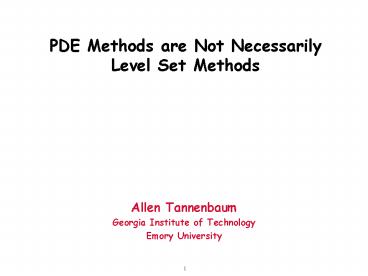PDE Methods are Not Necessarily Level Set Methods - PowerPoint PPT Presentation
1 / 47
Title:
PDE Methods are Not Necessarily Level Set Methods
Description:
How to Move Curves and Surfaces ... implicitly defined curves and surfaces. ... Sapiro, 'Geodesic active contours,' International Journal of Computer Vision, ... – PowerPoint PPT presentation
Number of Views:59
Avg rating:3.0/5.0
Title: PDE Methods are Not Necessarily Level Set Methods
1
PDE Methods are Not NecessarilyLevel Set Methods
- Allen Tannenbaum
- Georgia Institute of Technology
- Emory University
2
PDE Methods in Computer Vision and Imaging
- Image Enhancement
- Segmentation
- Edge Detection
- Shape-from-Shading
- Object Recognition
- Shape Theory
- Optical Flow
- Visual Tracking
- Registration
3
Scale in Biological Systems
4
Micro/Macro Models-Scale I
5
Micro/Macro Models-Scale II
6
How to Move Curves and Surfaces
- Parameterized Objects methods dominate control
and visual tracking ideal for filtering and
state space techniques. - Level Sets implicitly defined curves and
surfaces. Several compromises narrow banding,
fast marching. - Minimize Directly Energy Functional conjugate
gradient on triangulated surface (Ken Brakke).
7
Level Sets-A History
Independently Peter Olver (1976), Ph.D.
thesis Sigurd Angenent (Leiden University Report,
1982) Mathematical Justification Chen-Giga-Goto
(1991) Evans and Spruck (1991)
8
When Do They Work
9
Parameterized Curve Description
infinite dimensional
parameterization for derivations only, evolution
should be geometric
10
Generic Curve Evolution
The closed curve C evolves according to
11
Classification of Curve Evolutions
12
Classification of Curve Evolutions
Kass, Witkin, Terzopoulos, "Snakes Active
Contour Models," International Journal of
Computer Vision, pp. 321-331, 1988.
13
Classification of Curve Evolutions
Terzopoulos, Szeliski, Active Vision, chapter
Tracking with Kalman Snakes, pp. 3-20, MIT Press,
1992.
14
Classification of Curve Evolutions
Kichenassamy, Kumar, Olver, Tannenbaum, Yezzi,
"Conformal curvature flows From phase
transitions to active vision," Archive for
Rational Mechanics and Analysis, vol. 134, no. 3,
pp. 275-301, 1996. Caselles, Kimmel, Sapiro,
"Geodesic active contours," International Journal
of Computer Vision, vol. 22, no. 1, pp. 61-79,
1997.
15
Classification of Curve Evolutions
16
Static Approaches
Minimize
using the functionals
Kass snake (parametric)
Geodesic active contour (geometric)
17
Static Approaches
Kass snake (parametric)
Geodesic active contour (geometric)
18
Static Approaches
Minimizing
results in the gradient descent flow
Kass snake (parametric)
Geodesic active contour (geometric)
is an artificial time parameter
19
Dynamic Approach
Minimize the action integral
20
Dynamic Approach
Minimizing
using the functional
Terzopoulos and Szeliski (parametric)
21
Dynamic Approach
22
Dynamic Approach
But what about a geometric formulation?
23
Geometric Dynamic Approach
Minimize
using the Lagrangian
results in the Euler-Lagrange equation
24
Geometric Dynamic Approach
We can write
We then obtain the following two coupled PDEs for
the tangential and the normal velocities
The tangential velocity matters.
25
PDEs Without Level Sets Some Examples
26
Cortical Surface Flattening-Normal Brain
27
White Matter Segmentation and Flattening
28
Conformal Mapping of Neonate Cortex
29
Surface Warping-Area Preserving
30
Flame Morphing
31
Anisotropic active contours
- Add directionality
32
Curve minimization
Registration, Atlas-basedsegmentation
- Calculus of variations
- Start with initial curve
- Deform to minimize energy
- Steady state is locally optimum
- Dynamic programming
- Choose seed point s
- For any point t, determine globallyoptimal curve
t ? s
Segmentation
33
Synthetic example (3D)
34
Stochastic Approximations
35
Curvature Driven Flows
36
Euclidean and Affine Flows
37
Euclidean and Affine Flows
38
Birth/Death Zero Range Processes-I
- S discrete torus TN, WN
- Particle configuration space N TN
- Markov generator
39
Birth/Death Zero Range Processes-II
- Markov generator
40
Birth/Death Zero Range Process-III
- Markov generator
- Each particle configuration defines a positive
measure on the unit circle - To make the curve zero barycenter, a corrected
measure is used - Reconstruct the curve with
41
The Tangential Component is Important
42
Nonconvex Curves
43
Stochastic Interpretation-I
44
Stochastic Interpretation-II
45
Stochastic Interpretation-III
46
Stochastic Curve Shortening
47
Conclusions
- Level sets are a way of implementing curvature
driven flows. - Loss of information.
- Modifications are necessary.
- Do not work if no maximum principle.
- Combination with other methods, e.g. Bayesian.































